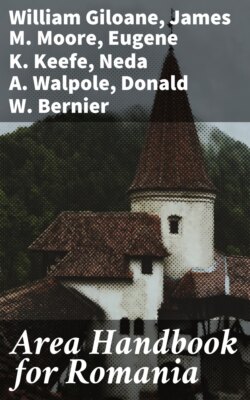Читать книгу Area Handbook for Romania - Eugene K. Keefe - Страница 13
На сайте Литреса книга снята с продажи.
CHAPTER 4 SOCIAL SYSTEM AND VALUES
ОглавлениеTable of Contents
Since the end of World War II Romanian society and its values have been in a state of flux. The aim of communist social and economic policies has been to destroy the old order and replace it with a new one that will reflect communist ideology. The resulting changes have been fundamental and far reaching, particularly in the structure of the society and the place occupied in it by particular individuals. The effect on values has been less easy to determine.
The extent and the pace of change have been slowing down since the early 1960s, and some aspects of the old social order were beginning to reemerge, although in different forms. The changes that were continuing to affect the society in the 1970s were more the result of economic growth than of conscious efforts to bring them about. This was particularly true of the changing role of the family, which has come about as a consequence of increased industrialization and urbanization as much as by government design.
Least affected by the social upheaval since 1945 have been the ethnic composition of the country and the relations between the various ethnic groups. Although the population has always been predominantly Romanian, Hungarians and Germans constitute a majority in some areas of the country and remain a source of potential political and social problems. The Hungarian minority in particular, making up more than 8 percent of the population in 1966, has always been very sensitive to what it considers Romanian domination and has at times harbored irredentist feelings.
ETHNIC COMPOSITION
The population of Romania is basically homogeneous, although it includes elements of almost every ethnic group in Central and Eastern Europe. At the time of the 1966 census, Romanians constituted 88 percent of the population. The largest single minority group were the Magyars, or Hungarians, constituting 8.4 percent of the population. They were followed by the Germans with 2 percent of the population. All other ethnic groups—Serbs, Croats, Slovenes, Ukrainians, Russians, Czechs, Slovaks, Turks, Tatars, Bulgarians, Jews and Gypsies—were simply listed as "other" and together made up only 1.6 percent of the population.
The Constitution of 1965 guarantees equal rights to all citizens regardless of nationality or race and stipulates legal sanctions against both discrimination and instigation of national or racial animosities. National minorities are guaranteed the free use of their mother tongue in education, the communications media, and their dealings with government authorities and unrestricted perpetuation of their cultural traditions.
Romanians
The origins of the Romanians and their language have been the subject of differing interpretations and controversy. Romanians are related to the Vlachs, a pastoral people speaking a Latin-derived language who are found in the mountainous regions of northern Greece and southern Yugoslavia.
According to Romanian tradition, Romanians are the direct descendants of the Dacians, who inhabited the territory of modern Romania before the Christian Era. The Dacians were conquered by Roman legions under Emperor Trajan in A.D. 106 and became romanized during 165 years of Roman control. When Emperor Aurelian abandoned control of Dacia in 271, in the face of Gothic invasions, the romanized Dacians sought refuge in the rugged Carpathian Mountains, where they preserved their Latin language and culture until more settled conditions allowed them to return to the plains in the tenth century (see ch. 2).
The period of Roman rule of Dacia is well documented, but the absence of any firm indication of the presence of a Latin-speaking population in the territory of contemporary Romania until the tenth century has given rise to another theory of the origin of Romanians, developed mostly by Hungarian historians. This theory maintains that the Dacians withdrew with the Roman legions south of the Danube. There they absorbed elements of Thracian and Slavic culture, in addition to that of their Roman rulers. Starting in the tenth century, a people speaking a Romance language moved northward across the Danube as far as Slovakia and settled in the area that later became Romania.
The Romanian theory of their origin stresses that a people speaking a Romance language continuously occupied the territory claimed by the Romanian state, thus rendering legitimacy to the claim. The other theory stresses the absence of a Romance-language-speaking people in Transylvania at the time of the Magyar immigrations into that region, thus giving legitimacy to the Hungarian claim to Transylvania.
Whatever their origin, Romanians have occupied the territory of their present state since the Middle Ages. In 1966 they numbered 16.8 million and formed the majority population in most of the country (see fig. 5).
Romanian, a Romance language, differs sharply from the languages of neighboring countries which, with the exception of Hungarian, are all Slavic tongues. The basis for Romanian seems to be the Vulgar Latin of ancient Rome. Long contact with Slavic-speaking peoples has left its mark on the vocabulary but has not affected grammar or syntax, which remain similar to those of other Romance languages. The vocabulary of literary Romanian is more purely of Latin origin than that of the spoken dialects. Frequently, parallel words of Latin and Slavic derivation exist for an object or concept and are used interchangeably. Turkish, Albanian, Hungarian, and German have also influenced the vocabulary of the spoken language in various parts of the country.
